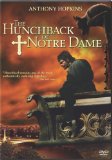Does the name Quasimodo ring a bell? It should, and he did. The deformed cathedral tower bell ringer first appeared in the famous French language novel by Victor Hugo. The story is one of the more frequently filmed tales, going back as far as 1923 and the silent film starring Lon Chaney. Chaney created the definitive appearance from his own collection of grease paints and handmade appliances. The physical restrictions he placed upon himself then nearly crippled the actor. Charles Laughton put his own stamp on the character in 1939. This would become the defining sound film. Even the Walt Disney Studios put their own unique stamp on the tale. Their animated version brought us a romantic tale alive with music and talking statues. With such a rich history of films to its credit, one might question why a made for television film could add anything more to the story. It was with that attitude that I entered the world of this Hunchback Of Notre Dame.
It turns out that there were actually several elements to be added. The most significant is creating a faithful adaptation of the original story. To date no one has come very close to depicting the likely unfilmable Hugo narrative, at least the English translations that I’ve been exposed to. With that in mind, I must say that this film just might come closest to the original tale. Hugo’s description of Quasimodo fits this presentation rather snugly. The next element to be added was a more complicated portrayal of the man himself. While both Chaney and Laughton brought him effectively to life, I don’t feel that either instilled him with as much humanity as Anthony Hopkins does here. Even beneath plenty of prosthetics, Hopkins brings such an array of emotion that I don’t think you’ll have looked at this character in quite this manner before, nor are you likely to in the future. This is the most complete portrayal I’ve seen. Finally, the story has seldom involved this level of detail to many of the supporting characters. The cast is impressive for any film, doubly so for a made for television release with a limited budget.
You probably know the story by now. Quasimodo (Hopkins) was taken in by a priest at the Notre Dame Cathedral in France. He had a hump on his back. He was short and almost troll-like in stature. He was blind in one eye and had a horribly deformed mouth. He spoke mostly in grunts and half formed sentences. One day he spots the gypsy Esmeralda (Down) dancing in the square below his perch in the Cathedral’s towers. He falls in love with her. Unfortunately one of the Cathedral’s clergy is also in love with the girl. Don Claude (Jacobi) is haunted by her beauty and would do anything to possess her for himself. To further complicate things, Esmeralda has agreed to marry the poet Pierre (Sundquist) to save him from execution. It seems the young lad has trespassed on gypsy soil and must be killed unless a woman among them is willing to claim him for a husband. Naturally, Esmeralda doesn’t love Pierre. She loves Captain Phoebus (Powell), who is married already but leads her on in order to sleep with her. When Quasimodo is captured trying to kidnap Esmeralda for the priest, he is beaten in the public square. Esmeralda takes pity and gives the tortured creature comfort and water. Now Quasimodo’s passion is complete. He rescues her from her own execution, framed for murder by the jealous priest. The act would bring the entire city to the gates of the Cathedral. Devastation and tragedy ensue.
Video
The Hunchback Of Notre Dame is presented in its original full frame broadcast format. Unfortunately this print is extremely rough. Contrast is almost non existent. It’s very difficult to make out any kind of detail at all. Dark scenes are even worse, with some of the worst black levels I’ve seen. The rest of the picture is marred by plenty of noise. Grain and compression artifact form a formidable team, making the image only barely watchable.
Audio
The Dolby Digital 2.0 track is no better. There is plenty of high end distortion. Sounds are muddy, offering very little balance or range. Even dialog gets lost in the shuffle of sounds. I understand this was merely a television broadcast, but the production crew took the task seriously and delivered an impressive film. Too bad no one took the time to deliver an impressive transfer. It stinks all the way around.
Special Features
Nothing
Final Thoughts:
This was a very noble effort that no one took the time to present in a manner worthy of the material. If this is indeed the best that could have been done, then someone somewhere committed a grievous offense for so badly preserving this effort. If a cast that included Anthony Hopkins and Robert Powell wasn’t worth investing a little time and money, one wonders why the film was released on DVD at all. God forbid this thing hits Blu-ray in this condition. It could set high definition back 20 years. I’d rent it just because it’s a good film. Try not to let the image and sound keep you away. Worth a watch in any condition. “I now present to you the greatest of morality plays. It was written by the greatest of morality poets.”







